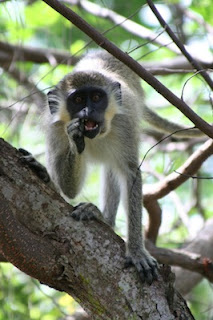Warning!
Don't read this if you are of a nervous disposition!
At
Balaba we have several chickens, but it's a bit of a battle trying to
make sure we always have enough, as they tend to have a short shelf
life here! If there is no fish, which happens quite often if it's
windy (because the boats don't go out in very rough seas), or during
the rainy season, when the fishermen are all farming to provide food
for next year, then sometimes we need to eat them (sorry, chicken
lovers!). They also eaten by predators, which view a chicken as a
tasty meal.
This
means chickens need to be replaced regularly. Recently Saffie was
given a beautiful cockerel (which she brought back on the bus all the
way from Basse 200 miles up river!), and Lamin's mum gave us a hen.
As they are new here, Lamin took out their flight feathers to stop
them flying away until they feel at home, although he assures me they will grow back! The
Balaba chickens roost in the trees – until I came to Balaba I had
no idea that chickens roosted in trees, but sure enough, at about
7:00 pm they flutter up into the trees, accompanied by much clucking
and fussing, and settle down for the night.
 |
| Our lovely new chickens |
As
our new chickens can't fly, Lamin housed them in an enclosed storage
area behind our house – when we got married so many visitors were
expected that Lamin built a large room at the back. He has since
enclosed the area between the house and the new room with walls and a
door. All kinds of things are stored there (remember, Gambians never
throw anything away), including several crates with bottles, some
tarpaulin, an old drum shell, and large bundles of cassava sticks
which are rooted in the ground ready to plant out in the rainy
season.
 |
| The enclosed storage area behind our house |
Last
night, about 1:00 am, I heard one of the chickens squawking. This is
never a good sign, because they are usually quiet at night until the
cockerel starts crowing at 4:00 am, so Lamin got up, opened our back
door, and had a look. Saffie, who sleeps in the attached room, also
had a look, but there was nothing to be seen. Lamin came back to bed,
but about 20 minutes later we heard it again. This time, when Lamin
opened the door, he closed it again, and without a word, went and
unlocked the front door, and shortly afterwards came back with a
large stick.
Still
silent, he went out the back door, and I heard him wedge something
heavy against it, to stop it swinging open. I then heard him start to
move the crates and other things, working only by torchlight. Now I
know that there are several animals here which like to eat chickens.
The fox (which is actually more like a mongoose than a British-style
fox), is quite common, but rats and snakes are also partial to a
tasty bird. If it had been a fox, Lamin would have taken his gun, and
he wouldn't have bothered too much about a rat, so that left only a
cobra! I lay in bed for what seemed like a very long time, wondering
how far we would have to travel to find anti-venom – I suspect we
would have needed to go to Banjul, a good hour's journey away,
although I wasn't too sure.
Lamin
continued moving things around, and I continued to lay and wait,
until at last I heard a heavy thud, followed by several more. After a
few minutes, I gingerly opened the back door, knocking over a heavy
spade in the process. On the ground was a cobra about a metre long,
and by now very dead. Apparently Lamin spotted the snake the second
time he looked out, and saw it slither under the crates.
 |
| A very dead cobra! |
Actually,
I love snakes – I think they are beautiful, as does Lamin, and
normally we would have let the snake survive, but this was in a
confined area which we all use regularly – my towel hangs on the
line out there, and there is a shower area too. In fact, it's likely
that the cobra got in through the drainage hole in the shower, as it
wasn't covered with mesh like the other drainage hole.
 |
| It's hard to see the very small drainage hole, but we think this is how the cobra got in. |
 |
| The other drainage hole, protected by mesh. |
Apparently
cobras like to scare chickens away and eat any eggs, but sometimes
they will kill a chicken, although they don't eat it. The last time
this happened when I was here, it was during the rainy season. Then
it was outside in the compound, and a much longer cobra actually
killed a chicken. Lamin killed the cobra and gave the chicken to a
local family, who stripped out the blood vessel with the venom and
then ate it – it's such a treat here that no-one would want to
waste a chicken!
So
I think our chickens are the luckiest on the planet, because there's
not much space out there, and they could easily have been caught.
But Lamin laughed when I told him I was wondering about where to get
anti-venom - all he said was “But I know how to kill a snake. It's
not a problem”. However, I don't think I would have liked to be in
a confined space with a cobra, moving stuff around and searching for
it by torchlight!
















